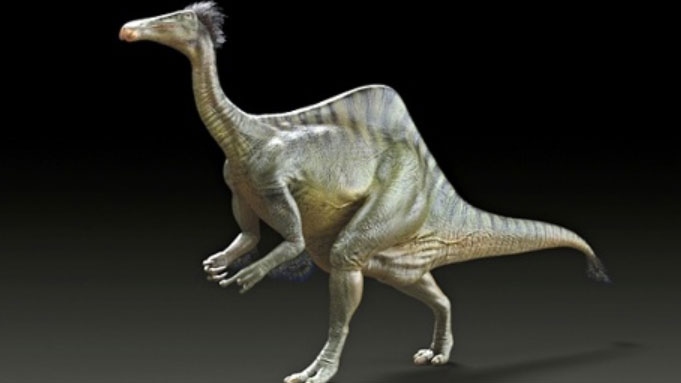Palaeontologists investigating public reports of fossil finds
The Badlands are a hotbed for fossil discovery and palaeontologists know they can't find all the exposed dinosaur bones because there's just not enough of them to cover the vast area.
Instead, they rely on the eyes of people hiking.
Francois Therrien is the curator of dinosaur palaeoecology at the Royal Tyrrell Museum in Drumheller and says the pandemic produced many amateur palaeontologists with people opting to vacation at local sites rather than exotic destinations.
"Here in Alberta we're really lucky," he said. "Wherever you go in the province you are on rocks that were formed during the age of the dinosaurs so there's always potential of finding fossils."
Therrien says fossils in Alberta are protected by law, they're not the property of the landowner or of the person who discovered them. They belong to the government, which protects and maintains them for in the best interest of all Albertans.
"We ask people to keep an eye open wherever you go hiking, fishing, camping and if you find fossils, take photos, GPS coordinates, a dot on the map," said Therrien. "Then report that to the Royal Tyrrell Museum and we'll follow up on your find and let you know if what you found is something significant."
RED DEER RIVER VALLEY
The Red Deer River valley is a particular interest for scientific research because it represents a time of 70 million years ago that scientists want to learn more about along with the dinosaurs that lived during that time. Therrien says the landscape constantly changes from year to year.
"In the Badlands the rate of erosion is really rapid, we're talking sometimes up to one centimeter of erosion per year," he said. "So even if you walk on the surface of an outcrop one year, you come back the following year, erosion could have exposed other fossils so that's why it's really important to always come back to the same areas, it may be year after year or every other year to see what new fossils are coming up at the surface due to erosion."
DUCKBILL DINOSAUR
Therrien says at the beginning of October museum staff uncovered many bones from a duckbill dinosaur. With the help of Kneehill County staff and their motorized equipment, the specimens were excavated, protected in a plaster coating and transported to the Royal Tyrrell.
Jared Voris is a dinosaur palaeontologist and PhD student at the University of Calgary and says he investigates a number of public dinosaur finds in places where bones haven't been found before.
 Scientists have described dinosaur Deinocheirus mirificus as goofy and weird. (Yuong-Nam Lee / KIGAM)
Scientists have described dinosaur Deinocheirus mirificus as goofy and weird. (Yuong-Nam Lee / KIGAM)
"Those are really nice finds when people find those and so I basically try and follow up in every way I possibly can," said Voris. "Whenever people find fossils, it's just an amazing thing and it's just great to share that sense of discovery with the general public and people who just want to come out here and look for fossils."
Therrien says when fossils are uncovered and transported to the museum they undergo a triage of sorts. If they're determined to be a high priority specimen, technicians will work to reveal the bones from the rock for scientific study.
Learn more about the museum here: www.tyrrellmuseum.com
CTVNews.ca Top Stories

Joe Biden pardons son Hunter Biden of gun, tax charges, despite promising not to
U.S. President Joe Biden announced Sunday that he pardoned his son Hunter Biden on gun, tax charges, despite previous promises that he would not do so.
Canada Post presents union with 'framework' to reach deal as strike continues
Canada Post has presented the union representing some 55,000 striking postal workers with a framework to reach negotiated agreements, the corporation said.
'Devastating': Missing Surrey, B.C. teen found dead, family says
The family of a missing 18-year-old, who was last seen in Surrey over a month ago, says there has been a tragic end to the search.
The best tips to prepare your car for the winter
Slippery or snow-covered roads, reduced visibility and bitter cold are all conditions that can make driving difficult and even dangerous during cold weather months. CAA spoke with CTV Morning Live this week on some of the best ways you can winterize your car.
PM Trudeau 'surprised' provinces unanimous on accelerated defence spending: Ford
Ontario Premier Doug Ford says his fellow provincial leaders are united in pushing for Canada to meet its NATO defence spending targets ahead of schedule, and that Prime Minister Justin Trudeau was "surprised" to hear it.
Stellantis CEO resigns as carmaker sales continue to slump
Stellantis CEO Carlos Tavares is stepping down after nearly four years in the top spot of the automaker, which owns car brands like Jeep, Citroën and Ram, amid an ongoing struggle with slumping sales.
'Wicked' star Marissa Bode speaks out against 'harmful' ableist comments made about her character
'Wicked' actress Marissa Bode posted a video on TikTok asking for kindness after receiving ableist comments on social media.
Poilievre calls for asylum seeker cap, border plan as U.S. tariff threat looms
Conservative Leader Pierre Poilievre has demanded the federal government present a plan before Parliament to beef up border security as U.S. president-elect Donald Trump threatens to impose stiff tariffs on Canada.
Emergency crews battle large fire at Kitchener, Ont. townhouse complex
Waterloo Regional Police say Kingsway Drive will remain closed as emergency crews continue to battle a large blaze at a townhouse complex.


































